CACNB4
This article may be too technical for most readers to understand. (November 2009) |
| CACNB4 | |||
|---|---|---|---|
Gene ontology | |||
| Molecular function | |||
| Cellular component | |||
| Biological process | |||
| Sources:Amigo / QuickGO | |||
| View/Edit Human | View/Edit Mouse |
Voltage-dependent L-type calcium channel subunit beta-4 is a protein that in humans is encoded by the CACNB4 gene.[5][6]
Function
This gene encodes a member of the beta subunit family, a protein in the voltage-dependent calcium channel complex. Calcium channels mediate the influx of calcium ions into the cell upon membrane polarization and consist of a complex of alpha-1, alpha-2/delta, beta, and gamma subunits in a 1:1:1:1 ratio. Various versions of each of these subunits exist, either expressed from similar genes or the result of alternative splicing. The protein described in this record plays an important role in calcium channel function by modulating G protein inhibition, increasing peak calcium current, controlling the alpha-1 subunit membrane targeting and shifting the voltage dependence of activation and inactivation. Alternate transcriptional splice variants of this gene, encoding different isoforms, have been characterized.[6]
Clinical significance
Certain mutations in this gene have been associated with idiopathic generalized epilepsy (IGE) and juvenile myoclonic epilepsy (JME).[6]
Interactions
CACNB4 has been shown to
See also
- Voltage-dependent calcium channel
References
- ^ a b c GRCh38: Ensembl release 89: ENSG00000182389 – Ensembl, May 2017
- ^ a b c GRCm38: Ensembl release 89: ENSMUSG00000017412 – Ensembl, May 2017
- ^ "Human PubMed Reference:". National Center for Biotechnology Information, U.S. National Library of Medicine.
- ^ "Mouse PubMed Reference:". National Center for Biotechnology Information, U.S. National Library of Medicine.
- PMID 9628818.
- ^ a b c "Entrez Gene: CACNB4 calcium channel, voltage-dependent, beta 4 subunit".
- PMID 9442082.
- PMID 10212211.
Further reading
- Volsen SG, Day NC, McCormack AL, et al. (1997). "The expression of voltage-dependent calcium channel beta subunits in human cerebellum". Neuroscience. 80 (1): 161–74. S2CID 27406120.
- Lory P, Ophoff RA, Nahmias J (1997). "Towards a unified nomenclature describing voltage-gated calcium channel genes". Hum. Genet. 100 (2): 149–50. S2CID 21167466.
- Taviaux S, Williams ME, Harpold MM, et al. (1997). "Assignment of human genes for beta 2 and beta 4 subunits of voltage-dependent Ca2+ channels to chromosomes 10p12 and 2q22-q23". Hum. Genet. 100 (2): 151–4. S2CID 5689556.
- Walker D, Bichet D, Campbell KP, De Waard M (1998). "A beta 4 isoform-specific interaction site in the carboxyl-terminal region of the voltage-dependent Ca2+ channel alpha 1A subunit". J. Biol. Chem. 273 (4): 2361–7. PMID 9442082.
- Betz R, Leibiger B, Farnebo F, et al. (1998). "Mapping of the human Ca2+ channel beta 4 subunit to 2q22-23 and its expression in developing mouse". Mamm. Genome. 9 (4): 310–1. S2CID 43010915.
- Day NC, Volsen SG, McCormack AL, et al. (1998). "The expression of voltage-dependent calcium channel beta subunits in human hippocampus". Brain Res. Mol. Brain Res. 60 (2): 259–69. PMID 9757060.
- Walker D, Bichet D, Geib S, et al. (1999). "A new beta subtype-specific interaction in alpha1A subunit controls P/Q-type Ca2+ channel activation". J. Biol. Chem. 274 (18): 12383–90. PMID 10212211.
- Escayg A, De Waard M, Lee DD, et al. (2000). "Coding and noncoding variation of the human calcium-channel beta4-subunit gene CACNB4 in patients with idiopathic generalized epilepsy and episodic ataxia". Am. J. Hum. Genet. 66 (5): 1531–9. PMID 10762541.
- Helton TD, Horne WA (2002). "Alternative splicing of the beta 4 subunit has alpha1 subunit subtype-specific effects on Ca2+ channel gating". J. Neurosci. 22 (5): 1573–82. PMID 11880487.
- Strausberg RL, Feingold EA, Grouse LH, et al. (2003). "Generation and initial analysis of more than 15,000 full-length human and mouse cDNA sequences". Proc. Natl. Acad. Sci. U.S.A. 99 (26): 16899–903. PMID 12477932.
- Finlin BS, Crump SM, Satin J, Andres DA (2004). "Regulation of voltage-gated calcium channel activity by the Rem and Rad GTPases". Proc. Natl. Acad. Sci. U.S.A. 100 (24): 14469–74. PMID 14623965.
- Chen YH, Li MH, Zhang Y, et al. (2004). "Structural basis of the alpha1-beta subunit interaction of voltage-gated Ca2+ channels". Nature. 429 (6992): 675–80. S2CID 4422712.
- Suzuki Y, Yamashita R, Shirota M, et al. (2004). "Sequence comparison of human and mouse genes reveals a homologous block structure in the promoter regions". Genome Res. 14 (9): 1711–8. PMID 15342556.
- Gerhard DS, Wagner L, Feingold EA, et al. (2004). "The status, quality, and expansion of the NIH full-length cDNA project: the Mammalian Gene Collection (MGC)". Genome Res. 14 (10B): 2121–7. PMID 15489334.
- Vendel AC, Rithner CD, Lyons BA, Horne WA (2006). "Solution structure of the N-terminal A domain of the human voltage-gated Ca2+channel beta4a subunit". Protein Sci. 15 (2): 378–83. PMID 16385006.
- Vendel AC, Terry MD, Striegel AR, et al. (2006). "Alternative splicing of the voltage-gated Ca2+ channel beta4 subunit creates a uniquely folded N-terminal protein binding domain with cell-specific expression in the cerebellar cortex". J. Neurosci. 26 (10): 2635–44. PMID 16525042.
- von Brevern M, Ta N, Shankar A, et al. (2006). "Migrainous vertigo: mutation analysis of the candidate genes CACNA1A, ATP1A2, SCN1A, and CACNB4". Headache. 46 (7): 1136–41. S2CID 40915635.
- Kobayashi T, Yamada Y, Fukao M, et al. (2007). "The GK domain of the voltage-dependent calcium channel beta subunit is essential for binding to the alpha subunit". Biochem. Biophys. Res. Commun. 360 (3): 679–83. PMID 17618603.
External links
- CACNB4+protein,+human at the U.S. National Library of Medicine Medical Subject Headings (MeSH)
- Human CACNB4 genome location and CACNB4 gene details page in the UCSC Genome Browser.
- Overview of all the structural information available in the PDB for UniProt: O00305 (Voltage-dependent L-type calcium channel subunit beta-4) at the PDBe-KB.
This article incorporates text from the United States National Library of Medicine, which is in the public domain.


